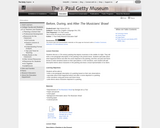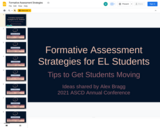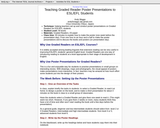
A list of tips for content teachers with beginning English learners in their classroom.
- Subject:
- English as a Second Language
- Material Type:
- Reference Material
- Date Added:
- 10/30/2019

ESL Resources on #GoOpenNC

A list of tips for content teachers with beginning English learners in their classroom.

Adjectives worksheets for ESL students. Conversational worksheets using adjectives; with matching writing exercises on page 2.

I used the idea of the Virtual Word Wall from the Ready, Set, Coteach team. This blank template is just a Google Slide with a table. You can customize the numbers of rows or column, as well as anything else when you make your own copy. I like consistency for the user experience, in this case, first grade English Learners. So the colors stay the same and the format is the same each week.While mine focus on supporting our new adoption of HMH Into Reading, a virtual word wall can work in any content area, at any age level. It could also be in a World Language setting.

Students will be able to write a one-paragraph description of a painting based on their own observations; speculate about what happened before and after a scene depicted in a painting; write narratives using past tense and future tense; and write idioms about characters depicted in a painting.

This lesson serves as a review for line, shape, color, and pattern for all students. The lesson also reinforces these concepts in english for ESL students. All students participate in speaking, writing and creating activities. Also, students are introduced to the NC Museum of Art through a virtual field trip.

This lesson serves as a review for line, shape, color, and pattern for all students. The lesson also reinforces these concepts in english for ESL students. All students participate in speaking, writing and creating activities. Also, students are introduced to the NC Museum of Art through a virtual field trip.

Students will select their own readings and write short reports about them, they will present their readings and reports in small groups and then, to the class showing presentation skills, such as eye contact, oral fluency, and posture. This resource supports English language development for English language learners.

Students will research about events from the world and home country a year in the past, they will make predictions about the same events a year in the future and give a presentation to the class as a whole. This resource supports English language development for English language learners.

As part of their ELA coursework, students are reading an autobiography to study author's craft. In particular, students are exploring how authors use dialogue, transitional phrases/clauses, and sensory details to tell a personal story. The unit will culminate with students writing their own memoirs. The bulk of the unit takes place in the ELA classroom. In the ESL support block, students will receive support with reading an autobiography of their choice, noting examples of author's craft in the autobiography, and integrating this craft into their own writing.
In this first lesson of the unit, students choose from two memoirs 15 on the Road to Freedom and the Big Lie. Students participate in a F2F mini-lesson in how dialogue can develop characters in an autobiography. Students then transition to technology for a book introduction with historical context and a chapter 1 book preview (guided reading). Students in 15 on the Road to Freedom then continue to receive support via Ed Puzzle for identifying dialogue and documenting in a graphic organizer, while students in The Big Lie meet with the teacher for the support. While students in The Big Lie transition to continue completing the graphic organizer independently, students in the 15 on the Road to Freedom meet with the teacher F2F to discuss their completed graphic organizers. Students then return to their autobiographies (written on google docs and organized in google classroom) to include additional dialogue in their stories and peer-review a partnerÅ› story. Students then participate in a full group F2F wrap up/reflection where they share out examples of dialogue their partner included in their writing as a result of the lesson.
Online Lesson for Books: Historical Context/Chapter 1 Intro/Graphic Organizer Support
15 on the Road to Freedom: Book Introduction, Chapter 1 Preview, and Support with Graphic Organizer Task
The Big Lie: Book Introduction, Chapter 1 Preview (Note that support with graphic organizer is given F2F for this group)
Graphic Organizers
I can identify how authors use dialogue to develop characters
I can identify precise language authors use to introduce dialogue
I can identify how authors use sensory details to develop experiences
I can identify how authors use transitional words, phrases, and clauses to convey sequence shifts
Assignment Sheet
ELA Autobiography Assignment Sheet (Created by Julia Koli, Connie Ray, and Elliot Willis-Begley at Scarlett Middle School, Ann Arbor MI)
F2F Mini-Lesson #1
Mini-Lesson on Character Development Through Dialogue
Please email daughertye@aaps.k12.mi.us if you would like me to send you the additional resources I created for the remaining mini-lessons and book chapters!

Students will gain an understanding of using contractions in speaking and in written text. They will identify word pairs used to make contractions and create contractions appropriately. They will also have a better understanding of how certain grammatical structures, like contractions, contribute to the overall understanding of a text.

Students will gain an understanding of using contractions in speaking and in written text. They will identify word pairs used to make contractions and create contractions appropriately. They will also have a better understanding of how certain grammatical structures, like contractions, contribute to the overall understanding of a text.

Students will gain an understanding of using contractions in speaking and in written text. They will identify word pairs used to make contractions and create contractions appropriately. They will also have a better understanding of how certain grammatical structures, like contractions, contribute to the overall understanding of a text.

In this lesson students look at primary source images and read short secondary texts to understand slave life. In the activity, the teacher models and students practice differentiating between different types of text (primary, secondary, etc.) they might encounter in the social studies classroom. Students show their understanding of a passage's central concepts by selecting words and phrases to compose a "found poem" about the main ideas of the text. This lesson was designed for struggling readers and ESL/ELL students.

In this lesson students will learn how to express their feelings and emotions in a healthy manner.

9 formative assessment strategies that will help teachers assess student learning as well as promote student communication, collaboration, and critical thinking. Ideas sourced from ASCD annual conference presentation.

In this lesson students will compare different fruits from MyPlate.

Students will create posters based upon graded readers and present the posters to classmates. The lesson provides a template for the posters, instructions for presentations, and tips on student notetaking. This resource supports English language development for English Language Learners.

In this lesson student will learn how to talk and ask about health and sickness.

A look at how different environments affects how people live, work and play.

The remote learning lesson plan is based on Steven M. Constantino's five principles of family engagement. Parents work as co-teachers to help second-grade ESL students complete the how-to writing lesson. Students will practice listening, reading, speaking, writing, and interacting to create and explain different projects. They will make and fly paper airplanes while measuring the flight distances, explain where to find hidden treasure, and share how to create a favorite dish in the kitchen. During the lesson, students interact with family members, teachers, and classmates.